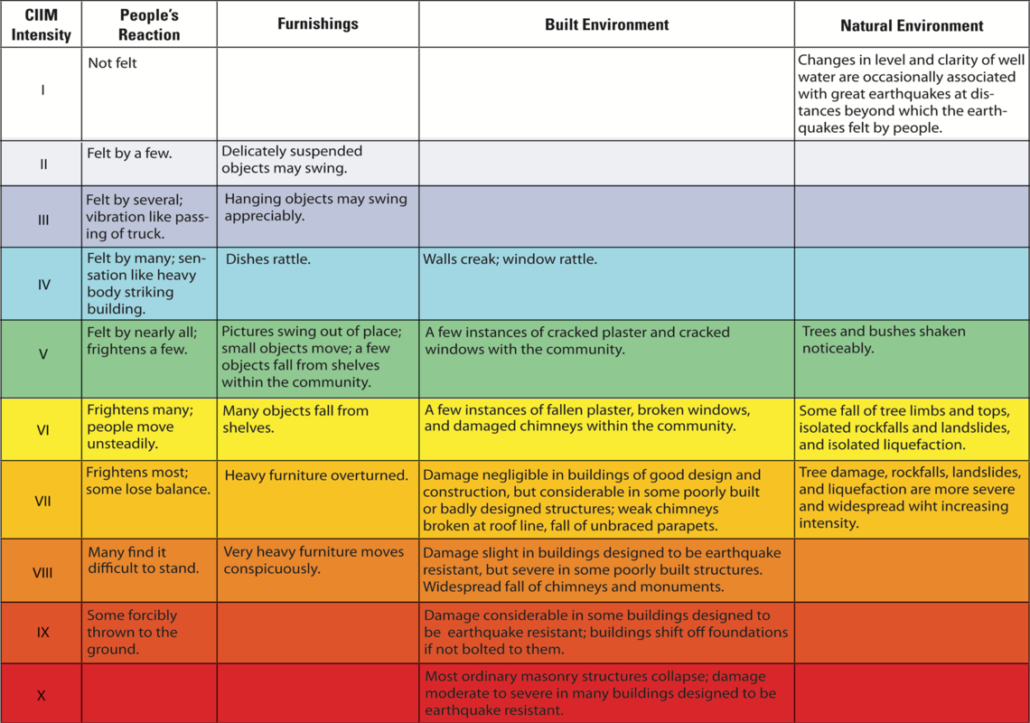Most of us are familiar with the magnitude ratings used to quantify the strength of earthquakes, but what do those numbers really mean? Learn about the systems scientists use to measure earthquake strength beyond the Richter scale.
The magnitude 9.0 earthquake in Japan in 2011 killed 16,000 people and damaged or destroyed more than 400,000 buildings; the magnitude 7.0 quake in Haiti in 2010 resulted in a staggering 316,000 deaths; the 2008 quake of magnitude 7.9 in China’s Sichuan province injured almost 400,000 people and left 4.8 million homeless.
Scientists rate earthquakes on two common factors: magnitude, or the amount of seismic energy released; and intensity, or how the earthquake felt to humans and its effect on structures.
Defining Earthquake Magnitude – Types of Scales
Richter Scale
Most Americans still associate the concept of earthquake magnitude with the Richter Scale, published by Charles Richter in 1935 (PDF link). Aiming to assess the strength of earthquakes in Southern California, Richter used measurements of seismic waves combined with their distance from the earthquake epicenter to create a magnitude rating system.
The Richter Scale (more accurately referred to now as the “local magnitude” scale or ML), like all other magnitude scales to follow, is logarithmic, meaning each unit up on the scale equals a 10-fold increase in amplitude–e.g. a 7.0 earthquake is 10 times stronger than a 6.0 earthquake, and 100 times stronger than a 5.0 earthquake.
However, the energy released by a seismic wave is 101.5 (or about 31.6x) the amount of its amplitude, meaning that a 7.0 quake releases 31.6 times more energy than a 6.0 quake, or 1,000 times more energy than a 5.0 quake.
Earthquakes Larger Than 7.0 – Moment Magnitude Scale
The Richter scale worked well for earthquakes up to 7.0, but became saturated at that point, failing to accurately differentiate major and “great” earthquakes. Enter the “moment magnitude” scale (Mw).
Designed to adhere closely to local magnitude ratings, the moment magnitude scale uses the earthquake’s “moment”–a calculation involving the ratio of shear stress to shear strain, the average amount of slip on the fault, and the total affected area of the quake. Since 2002, the United States Geological Society has used moment magnitude as its official earthquake rating system.
Unlike local magnitude (or other magnitudes like body-wave (Mb) or surface-wave (Ms) magnitude), moment magnitude does not saturate at high levels, meaning there is technically no upper limit. The highest magnitude earthquake ever recorded was the 9.5 Valdivia Earthquake that struck Chile in 1960.
However, don’t get too cocky when correcting someone who refers to a earthquake’s Richter rating. The modified Richter Scale still survives. For smaller earthquakes, the seismic moment often isn’t measured, meaning that ratings for earthquakes under 4.0 are most usually based on local magnitude, or, you guessed it, that old modified Richter Scale.
Defining Earthquake Intensity – Modified Mercalli Intensity Scale
Scientists calculate the magnitude of an earthquake based on geological events, i.e. measurable forces that occur within the earth. To describe and record how the earthquake felt to humans in its affected area, we use the term “intensity,” which has a scale all its own: the Modified Mercalli Intensity Scale. The Mercalli Scale assesses how a quake directly affected humans, structures, and the landscape itself.
Originally formulated by Italian volcanologist Giuseppe Mercalli (and revised several times by Germans, Italians, and Americans), the Mercalli Scale now includes 12 roman-numeral ratings from I (Not Felt) to XII (Extreme). The lower numbers on the scale (I-VI) are generally based on how humans experienced the earthquake; the higher numbers (VII-XII) are more determined by the amount of damage to buildings and property.

Magnitude vs. Mercalli
Though it’s the magnitude rating that makes the news, it’s the Mercalli rating that more accurately describes the effect of the earthquake on local residents. A good example of this difference is a comparison of the devastating 2011 Christchurch earthquake and a much larger magnitude earthquake that struck the area in November 2016.
While the February 2011 quake in Christchurch rated a 6.3 on the moment magnitude scale, it devastated the area, killing 185 people and destroying multiple large buildings. It rated a X (Extreme) on the Mercalli Scale.
The much larger magnitude Kaikoura earthquake in 2016 rated a moment magnitude of 7.8, yet resulted in far less damage to citizens and structures. The quake severely damaged some roads and bridges, but only two people died. That earthquake raked a VIII (Severe) on the Mercalli Scale.
(Jumpstart payments are linked to intensity, not magnitude. The triggering intensity is an MMI of VII-1/2.)
Two (of several) factors that may have contributed to the different earthquake intensities in New Zealand were the location and depth of the earthquakes. The 2011 quake struck Christchurch directly, whereas the 2016 earthquake centered slightly farther north, in a more remote area. The 2011 quake occurred at a level of 3 miles below ground, while the 2016 quake occurred deeper, at an estimated 15 miles below ground.
Popularized almost a century ago, the science of rating earthquakes continues to evolve, yet all signs point to us humans sticking with a logarithmic scale under 10 for the foreseeable future. (Just don’t call it the Richter Scale.)
Reviewed by Victoria Chames. Original publish date August 21, 2018.

